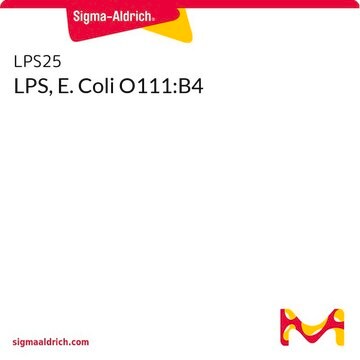Products may be shipped at a different temperature than the recommended long-term storage temperature. If the product quality is sensitive to short-term exposure to conditions other than the recommended long-term storage, it will be shipped on wet or dry-ice. If the product quality is NOT affected by short-term exposure to conditions other than the recommended long-term storage, it will be shipped at ambient temperature. As shipping routes are configured for minimum transit times, shipping at ambient temperature helps control shipping costs for our customers. For more information, please refer to the Storage and Transport Conditions document: https://www.sigmaaldrich.com/deepweb/assets/sigmaaldrich/marketing/global/documents/316/622/storage-transport-conditions-mk.pdf
推薦產品
生物源
Escherichia coli (O55:B5)
品質等級
形狀
lyophilized powder
純化經由
gel-filtration chromatography
雜質
<3% Protein
顏色
white to faint gray
溶解度
water: soluble
運輸包裝
ambient
儲存溫度
2-8°C
尋找類似的產品? 前往 產品比較指南
一般說明
應用
生化/生理作用
準備報告
相關產品
訊號詞
Danger
危險聲明
危險分類
Acute Tox. 2 Oral
儲存類別代碼
6.1A - Combustible acute toxic Cat. 1 and 2 / very toxic hazardous materials
水污染物質分類(WGK)
WGK 3
閃點(°F)
Not applicable
閃點(°C)
Not applicable
個人防護裝備
Eyeshields, Gloves, type N95 (US)
從最近期的版本中選擇一個:
分析證明 (COA)
客戶也查看了
文章
Explore the structure, function, and diverse applications of Lipopolysaccharides. Discover their role in bacteria, serological specificity, and research potential.
相關內容
Lipopolysaccharide (LPS) is a major component of Gram-negative bacteria, important for microbiological research.
脂多醣 (LPS) 是革蘭氏陰性細菌的主要成分,對微生物研究非常重要。
-
How is shipping temperature determined? And how is it related to the product storage temperature?
1 answer-
Helpful?
-
-
How can I determine the shelf life / expiration / retest date of this product?
1 answer-
If this product has an expiration or retest date, it will be shown on the Certificate of Analysis (COA, CofA). If there is no retest or expiration date listed on the product's COA, we do not have suitable stability data to determine a shelf life. For these products, the only date on the COA will be the release date; a retest, expiration, or use-by-date will not be displayed.
For all products, we recommend handling per defined conditions as printed in our product literature and website product descriptions. We recommend that products should be routinely inspected by customers to ensure they perform as expected.
For products without retest or expiration dates, our standard warranty of 1 year from the date of shipment is applicable.
For more information, please refer to the Product Dating Information document: https://www.sigmaaldrich.com/deepweb/assets/sigmaaldrich/marketing/global/documents/449/386/product-dating-information-mk.pdfHelpful?
-
-
What is the molecular weight of this product ?
1 answer-
Lipopolysaccharides(LPS) are heterogeneous and do not have fully defined molecular weights. In the presence of strong surface active agents, and in the absence of divalent cations, LPS will have molecular weights in the range of 10?20 kDa. Please see the link below to review additional information regarding the nature of LPS, including molecular weight variability:
https://www.sigmaaldrich.com/US/en/technical-documents/technical-article/research-and-disease-areas/cell-signaling/lipopolysaccharidesHelpful?
-
-
Can I use DPBS to dilute? or just use water?
1 answer-
This product is tested for solubility at 5 mg/mL in water. Aqueous buffers such as DPBS are expected to be suitable as well. Pease see the link below to review a reference that may be helpful:
https://www.ncbi.nlm.nih.gov/pmc/articles/PMC5685187/Helpful?
-
Active Filters
我們的科學家團隊在所有研究領域都有豐富的經驗,包括生命科學、材料科學、化學合成、色譜、分析等.
聯絡技術服務




